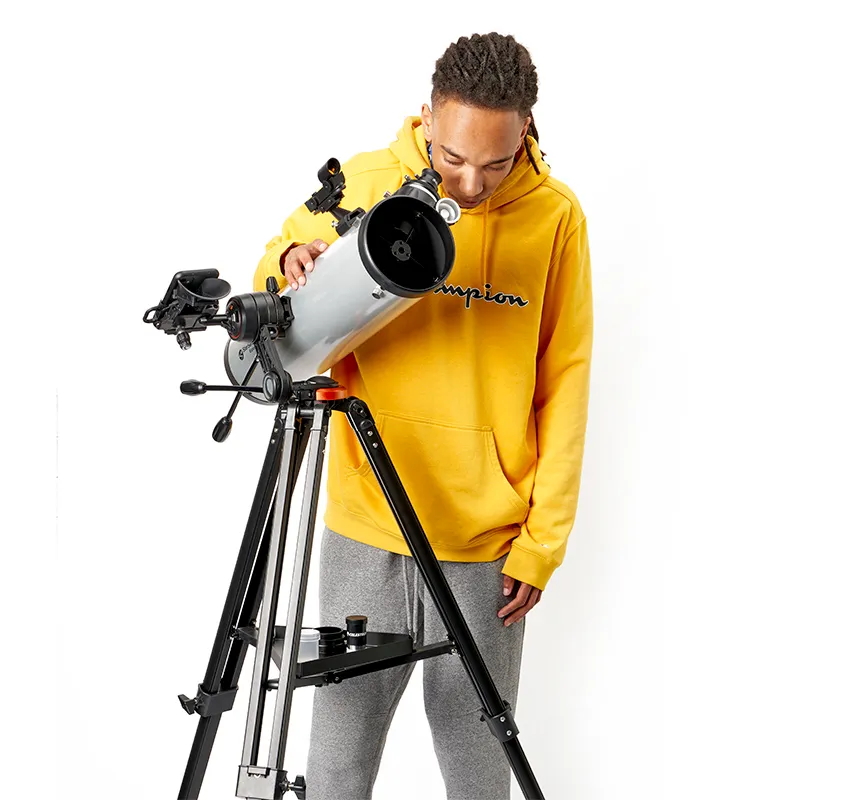The new Sightron Infini D50 set caught our eye as a budget, long-focal-ratio achromat in a market dominated by modern, short and fast refractors.
Could this grab-and-go kit deliver high-contrast views for budding astronomers?
- Discover our pick of the best beginner's telescopes


Unboxing and setting up the Sightron Infini D50
When our review package arrived, first impressions were – unsurprisingly for the price – that this is a basic, entry-level set.
And to a certain degree, this is true. However, we soon discovered that there is more to Sightron’s Infini D50 than meets the eye.
The manual altazimuth mount requires a modicum of assembly to attach the triangular spreader plate.
Once that’s in place, you’ll notice that the central pillar can no longer be fully lowered, leaving a minimum tripod height of around 60cm.

Each leg has two extensions and at maximum stretch the telescope sits 150cm from the ground.
The tripod section is constructed from aluminium, with plastic fittings making it lightweight and functional.
We appreciated the small rubber caps at the ends of the legs to dampen vibrations and prevent the legs skidding on hard surfaces. That’s a positive.
The negative is that these can slip off during use and are particularly difficult to find in the dark.
The mount feels sturdy and weighs around 500g, screwing onto the tripod via a standard 3/8-inch thread. The movement-control knobs are rubberised.

In use, they’re perfectly adequate, easy to use and capable of fine adjustments. Just note that using them does introduce significant vibration through the telescope and eyepiece.
The refractor itself is well constructed: the white tube is aluminium, as are most of the fittings except for the dual focusing knobs, which are 50mm in diameter and made of rigid plastic.
The tube attaches to the mount via a single thumbscrew in a Vixen-style bracket, ensuring it’s easy to set up, light to carry and highly portable.

How the Sightron Infini D50 performs
While waiting for the long summer twilight to recede into darkness, we picked out a few daytime terrestrial targets for alignment practice, including a bird in a distant tree and a rooftop TV aerial.
In much the same way that a familiar fragrance can transport you to times gone by, these simple views conjured up happy memories of hours spent, decades ago, with a simple telescope on a basic mount.
Before there were Go-To mounts, before ‘accessible astrophotography’ was a thing and long before smart telescopes, a simple refractor like the Sightron Infini D50 was the tool that first nurtured our love of backyard astronomy.
As the stars gradually emerged, we found ourselves falling in love with star-hopping again.
The hunt, and the reward that follows, has always been part of the thrill, and as we waited a couple of seconds for the vibrations to settle before eagerly scouring the view of our target, we found ourselves smiling.

The refractor has no mirrors to collimate, there’s no polar alignment to perform and no complicated app or handset to operate.
Along with open star clusters and beautiful coloured double stars like Albireo, we also tried to track down Messier list targets: the globular cluster in Hercules, M13, the Ring Nebula, M57, and the Dumbbell Nebula, M27.
The rudimentary finder on the Sightron meant placing these objects in the centre of the eyepiece proved a challenge, but the extended chase only served to enhance the thrill of the victory.
Any foibles of the mount were far outweighed by the sense of achievement as we toured the skies. If it isn’t clear by now, we thoroughly enjoyed using this little achromat!
The Sightron Infini D50 may just be the perfect telescope for discovering, or rediscovering, a love for pure and simple astronomy.
Its hands-on simplicity reconnects you, in a deeply personal way, with the night sky’s wonders.
With rewarding views at a modest price, the only upgrade we’d suggest is popping it on a different tripod.

Quality 50mm achromat lens
Japanese telescope lenses have a reputation for excellence.
Cue the 50mm achromatic objective lens in the Infini D50, which is multi-coated to reduce reflections and boost contrasts, with a relatively long focal length of 540mm.
We enjoyed good-quality star fields from this f/10.8 lens, tight and round, with a symmetrical airy disc at high magnification.
Stars were sharp over most of the centre of both eyepieces, providing high-quality observing opportunities – and not just at night.
Using our own solar filter, we observed several sunspots in exquisite detail and even managed to photograph them using a phone holder on the eyepiece.
On a 50%-illuminated Moon, a tour of the terminator revealed detail-rich views with almost zero colour fringing using the provided 23mm eyepiece.
The higher-magnification 10mm eyepiece helped to reveal the smaller Messier targets against a darker background, but both provided clear, high-contrast views. With our own 4.5mm eyepiece and clear views, we especially enjoyed observing all four stars in Epsilon Lyrae, the famous Double Double.

Sightron Infini D50 – 5 best features
Dew shield
The front of the optical tube is protected by an 80mm dew shield that keeps the lens tucked away from the elements and stray light. Unwanted reflections are further inhibited through the addition of internal tube baffles. The inside of the Infini D50 also features a matt-black coating to further enhance contrast.
Mini finder
A simple line-of-sight finder with a luminous pointer is attached to the tube and has two possible placement locations. Just behind this, a standard finderscope shoe bracket provides the option for an easier-to-use separate finder (not provided). We used a widely available 30mm unit to good effect.
Focuser
The focuser is a traditional rack-and-pinion type with single-speed control. The drawtube is a good length and offers 150mm of backwards travel, while the end of the tube is threaded to accept the 1.25-inch accessory holder. In use, the focuser was firm and smooth, while a single thumbscrew locks it in place.
Altaz controls
The mount head is eased into position by two simple control knobs. The altitude adjuster is quite close to the telescope, which may prove slightly awkward for those with large hands. It moves the telescope if turned quickly, but is responsive enough to allow slow and deliberate tweaks too.
Eyepieces
Two 1.25-inch starter eyepieces are included in the set. Both feature aspheric lenses with a 62° field of view. The 23mm offers a widefield view at 23x magnification, while the 10mm lens provides 54x magnification. They’re reasonably comfortable and provide views that keep you coming back for more.
Key specs
- Price: £389
- Optics: Achromatic refractor
- Aperture: 50mm
- Focal length: 540mm, f/10.9
- Focuser: Single-speed rack and pinion
- Mount: Altazimuth
- Extras: Star diagonal, 2x eyepieces, finder
- Weight: 3kg
- Supplier: First Light Optics
- Email: questions@firstlightoptics.com
- https://www.firstlightoptics.com
This review appeared in the October 2025 issue of BBC Sky at Night Magazine

